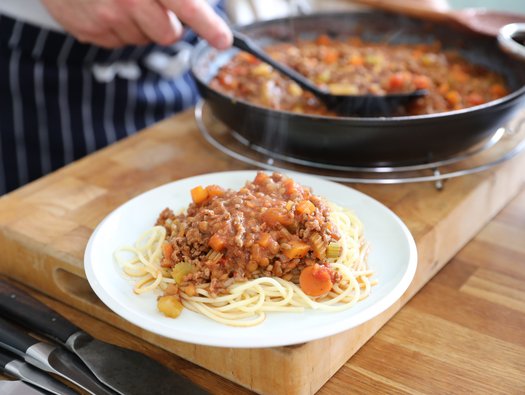Pasta Bolognese

An easy and tasty spaghetti Bolognese that is low in salt and high in protein, making it perfect for those on dialysis.

An easy and tasty spaghetti Bolognese that is low in salt and high in protein, making it perfect for those on dialysis.
1 tablespoon olive oil
125g onions, finely chopped
2 garlic cloves, crushed
100g carrots, finely chopped
50g celery, finely chopped
375g extra lean beef mince (5% fat)
1 teaspoon dried oregano
1 teaspoon dried basil
1 tablespoon tomato purée
400g tin chopped tomatoes
1 low-salt beef stock cube
Black pepper to taste
240g pasta
200g green lentils, tinned in water (drained and rinsed)
Heat half the oil over a medium heat in a large frying pan. Add the chopped onions, crushed garlic cloves, chopped carrots and celery and cook for 5-7 minutes until they are soft, stirring as they cook. Tip the cooked vegetables out of the pan and into a bowl to set aside.
Put the same pan back on the heat and add the remaining oil. Turn up the heat and add the minced beef to fry it. Keep stirring for at least 5 minutes until the mince is brown, breaking up any lumps. As the mince cooks, tip in the dried herbs.
Once the mince is browned all over, pour the cooked chopped vegetables back into the pan and mix thoroughly. Add the tomato purée and tin of chopped tomatoes and season with black pepper. Leave to simmer for 5-7 minutes on a low heat.
Make the beef stock with your low-salt stock cube and 500ml boiling water. Pour the stock into the pan, bring to the boil again and simmer for another 10 minutes, allowing the sauce to thicken.
Bring a saucepan of water to the boil. Add the pasta to the boiling water and cook according to the packet instructions. Once the Bolognese sauce has thickened, add the drained tinned lentils and stir. Simmer for 5 minutes more, to allow the lentils to warm through.
Drain the pasta and serve with the Bolognese sauce piled on top.
The pasta is the main sources of carbohydrate in this recipe, and the value has been provided for those who have been trained in insulin adjustment.
Despite the use of chopped tomatoes, this recipe is low in potassium, when following the quantities in the ingredients and the serving sizes. However, if you wish to reduce the potassium further, then you can omit the tomato puree and use tinned plum tomatoes and drain off the juice before adding.
This recipe is also low in phosphate, however it does contain some phosphate, provided by the beef mince and lentils, therefore if you have been prescribed a phosphate binder then you should take as directed.
Please note: If extras, such as cheese are added, then this will increase the phosphate or potassium of the dish and will no longer be considered low.
This recipe is high in protein, therefore suitable for those receiving dialysis. If you have been advised to reduce your protein then you could reduce the beef mince from 375g to 200g and replace the 200g tin of lentils with a 400g tin of lentils. Lentils are lower in protein than beef mince and this dish would also remain low in potassium and phosphate.
Use gluten-free stock cubes.
Use vegetable stock cubes and a vegan alternative to beef mince, such as soya mince.
Consider using a wholegrain pasta which will increase the fibre in this recipe.
If freezing, do not freeze the pasta. Once cooked, allow the Bolognese sauce to cool, then freeze in portions & store for up to 3 months. When ready to use, defrost thoroughly in the fridge and reheat until piping hot.
By giving us your email address, you're giving us permission to send you the latest news from Kidney Care UK. Further information about how we protect and use your personal data is available in our Privacy policy. If you would like to change the way we communicate with you at any time please email [email protected]. You can unsubscribe at any time by using the link at the bottom of every email we send.